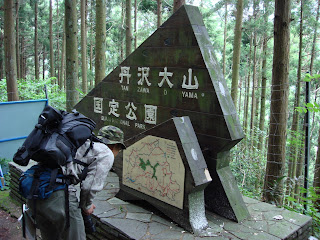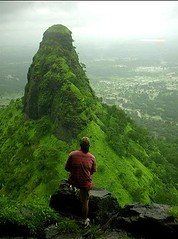Tanzawa National Park
General Outline :
For some people, "hiking" implies not taking a taxi from the front door to the train station. For others, it conjures images of fresh air, mountaintop vistas, and endless tree-filled horizons. Those in the latter category will appreciate that nature in all its glory - a treasury of oxygen, foliage, and spring water - beckons within an easy day trip of the choking city.
Verdant foothills and low mountains (mostly below 2000m) gird the Kanto plain to the south and west. Networks of trails follow the valleys and ridge lines, offering gradients ranging from rolling riversides to vertical rock climbs. With everything from torturous uphill routes for die-hards to cable-car assisted ascents from which to mock and pity them, there's something for everyone.
Unfortunately, everyone knows there is something for them: Hiking is very popular in Japan. On weekends, holidays, in the mornings and in areas closest to the city, expect crowded trails. On top of most mountains, expect a cold drink machine, a noodle shop, and groups of people sharing this special moment with a keitai and a pack of cigarettes.
While at times the terrain might resemble mountain trails in other parts of the world, hikers in Japan have their own idiosyncrasies. Since Bassho's day, many Japanese have taken up the sport as a panacea for woes of urban living - although, don't be surprised to see women wearing heels or sandals at Takao-san ( This one was visited on our previous outing ). On the trails, you will certainly meet caravans of mostly older Japanese (a prescription for health, they'll tell you) clad head to toe in matching Gore-Tex outfits, wool knickers, argyle socks, gaiters, heavy boots, and a towel around their neck. People often hike to the tinkling of bells or the strains of enka (folk music) from small transistor radios attached to their packs, and nearly all are friendly - but, as you utter your 20th "konnichi wa" in a row during a steep breathless ascent, you may begin to wish they weren't.
The best seasons for hiking in Kanto are spring (March to May) and autumn (October to December). It's not too hot, humid, or cold, there's little rain or mud, and the promise of bright green buds, blooming yama-zakura (mountain cherry trees), and purple azalea in spring and the fiery reds and oranges of koyo (foilage) in autumn is positively Pavlovian.
In the summer, humidity is high, there's rain and mud, but lush green forests and waterfalls keep you shaded and rested. Winter days are short and can be cold, but they reward hardier folks with fewer crowds, blue skies, clear views, and low humidity. Some of the higher peaks may also get frost, ice and/or snow.
Tanzawa and Oku-tama offer greater variety and longer, even multi-day treks.
This is one of favorite places in the extreme west end of Tokyo, known as Okutama. In fact, it is hard to believe that as you are standing in this mountainous area, you are still officially in tokyo. It is a great day trip and getaway because in one-and-a-half hours you can get away from the messy urban sprawl of tokyo city, and be amongst nature.
Sunday- 24.06.07
My Day started at 0500hrs, JST. Had a quick wash , a slice of bread and started calling others, asking them to get ready. As uaual I was ready on time by 0535 hrs waiting for others to get ready. Everyone ie. highbridge gang and myself , joined at Gyotoku station at 0600hrs.
From Gyotoku - Tozailine ( 0610 hrs ) reached Kayabacho - Hibiya line and Tozai line junction at 0630 hrs. We had to wait for Sathish and Meena to join us who had missed the train we had boarded and at 0638hrs they joined us at Kayabacho. From Kayabacho to Ebisu it was a silent ride with Subhajit joining us at Tsukiji. From Ebisu we boarded the JR line to Shinjuku - The world's busiest station with an average 3.2 million people using this station everyday. It is so vast that there are 200 exits ! On weekdays its just human sea moving in unison. Grim, drowsy faced crowd moving systematically bound for final destination.
Here in Shinjuku station, we switched to Odakyu Line express from Platform 4-5 to Shin-Matsuda. Joseph and Gokul had started 40 mins early as per our earlier schedule and were 40 mins ahead of us.We took the train at 0731 hrs. It was comfortably, long journey of nearly 1 hour 20 min. We reached Shin-Matsuda at 0853 hrs. The train fare from Shinjuku to Shin-Matsuda is 750 ¥. After reaching this station and it was decided the trek we had planned which is nearly 8 hours long really strenuous for newbies and ultimately in the end I was left alone to take up that trail. So I decided to take it up when my better half joins me. I think I will be attempting that trail in the fall time, in October or November when the whole forest range will be glowing in color. The other trail we decided which is " Omote-Tanzawa forest trail" required us to retrace our journey by one station, ie.Shibusawa.
The train fare from Shin-Matsuda to Shibusawa is 180 ¥. From Shibusawa station we had to take the central exit, turn right, and walk a few meters to the bus stand, and catch a No. 2 Kanagawa Chuo Kotsu bus for Okura. Here some of us took a break as the bus was at 0945 hrs and few of us were feeling hungry. The bus journey was short one with small individual houses, curvy roads sided by beautiful garden. The fare is 200 ¥.
The weather was gloomy with rain clouds blocking the sun. The total envirnment was calm and cool, with mountain range covered with tall coniferous kind of trees.
There is a board welcoming the hikers to Omote-Tanzawa Park. We took the road leading to the forest, a uphill tar road path. After walking for some ten minutes it started drizzling and it continued throughout the journey. Another ten minutes of walk, we took the small lane leading to the forest, which narrowed to a trail and ultimately joined the cold, damp, moss clad tree lines. It looked like this area had the rains for the last fortnight as the total way was really wet, muddy and moreover the tall trees were covered with moss and lichens. The canopy made the total walk, a dark , haunting one. After covering around 800 mts we reached a narrow ill maintained tar roads. As per the looks on the forest walls it looked like the forest had a constant landslide, changing the view all together. We could see some nets which was put on the vertical face of the forest floor on the steep curving. With mud and sludge covering and grass growing on it, it had effectively blocked the soil erosion. 

There is makeshift bridge of logs nailed and tied together to cross this river. The total area was grassy and moist with rains pouring and water dripping from the trees. This place is real damp with lot of big leeches. Since I was wearing my sandals, I was most affected with 4 leech bites and Now I can proudly say I have donated my blood in Tokyo blood donation camp! There are signs in Japanese cautioning the people about the area full of leeches.
We climbed again the path, which is really winding uphill and hard climbing. I had to climb this path 2 times because I was scouting the area. We again joined the main road and rain was picking up the strength. We met some Japanese hikers with fully geared from top to bottom with map of the camp. With insights from them we cut short our journey and took a shorter trail which directly connected us to the Shijuhasse River. The path was almost damp, slippery thin foot trail which brought us directly to the makeshift bridge. It was almost straight down with steep inclination. Everyone literally ran because of leeches ! After reaching the river we climbed the same uphill path by the side of Kokurya waterfall. Some were almost out of breath and about to collapse. After that the journey back was almost silent one split as 4 groups. Myself alone in the front and sai and sudheer making the second wave , Raj alone as the third wave . Rest all in a group nearly 10 minutes walk behind. The rain was really pouring heavily and we were drenched like old crows.
When We reached Okura, the starting point, it was 1600 hrs. We washed our selves at the common cleaning place, where one can clean their shoes too, to get ready for the urban appearance. Brush and flowing water is available for this, which of course is free or costs 0 ¥ !
Back home journey was really silent with most of the participants were sleeping and some even with their mouth open ! On the train Joseph pulled out the last of the leeches that had comfortably sucked enough blood from him. The leech had lost its home grounds and made a free ride till Machida , where we changed the train bound to shinjuku. It was around 2000 hrs that we reached our den.
Next week it may be Kamakura : The place known for Shrines, hiking trails and beach.







